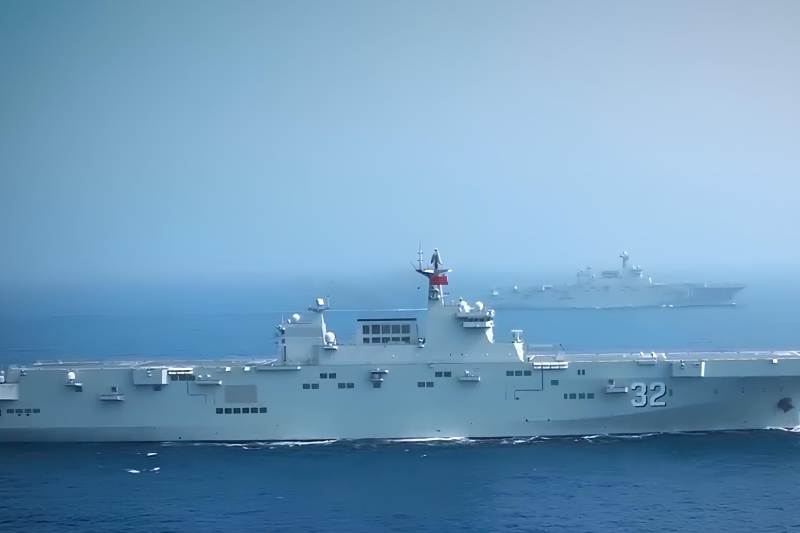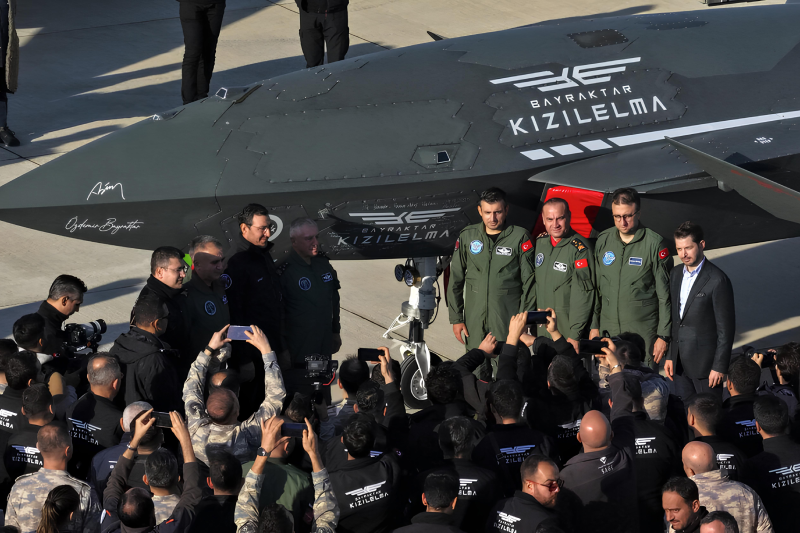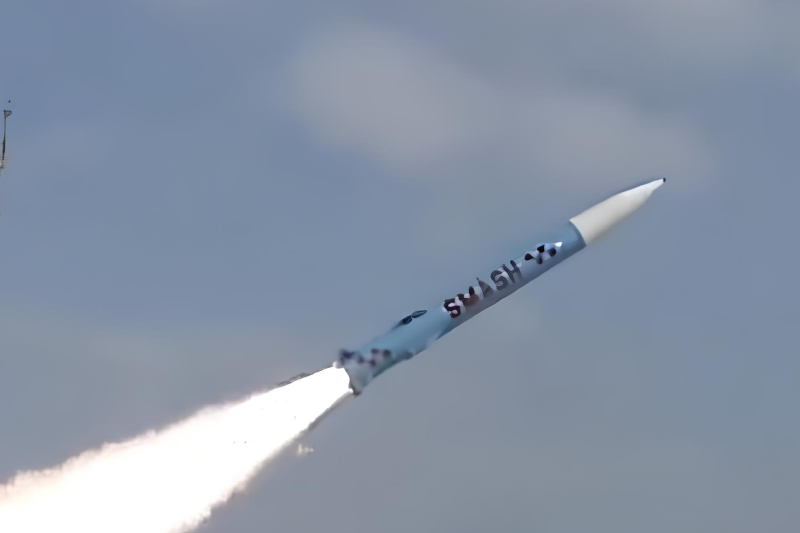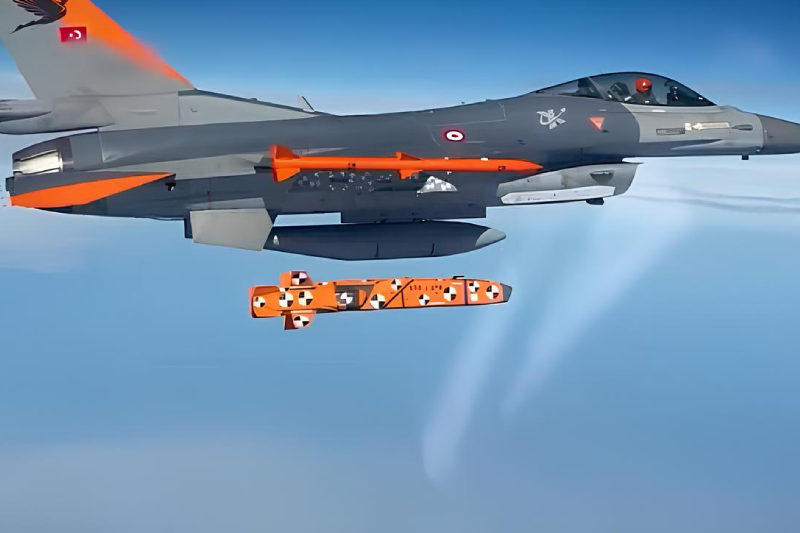Turkiye’s Test-Fires Indigenous SOM-J Cruise Missile Successfully
Turkiye has achieved a significant milestone in its defense industry development with the successful test launch of its indigenous SOM-J cruise missile, Industry and Technology Minister Mehmet Fatih Kacır announced Monday, highlighting the nation’s advanced engineering capabilities. The next-generation, medium-range, all-weather air-to-surface standoff SOM-J cruise missile developed by TÜBITAK’s Defense Industries Research and Development Institute (SAGE) demonstrated advanced evasion capabilities through complex maneuvers and low-altitude flight profiles during testing. The successful test represents a major step toward Turkiye’s goal of achieving complete defense industry independence while establishing the nation as a leading developer of advanced precision strike systems.
Minister Kacır emphasized that the SOM-J cruise missile demonstrates the level of engineering Turkiye has achieved in indigenous defense technology development. This achievement reflects years of systematic investment in research and development infrastructure, technical education, and defense industrial capacity building.
The successful test validates Turkiye’s progression from defense equipment importer to sophisticated weapons systems developer capable of producing cutting-edge technologies. This transformation positions Turkiye as a credible competitor in international defense markets while reducing dependence on foreign suppliers.
The SOM-J was developed by the Scientific and Technological Research Council of Turkiye’s Defense Industries Research and Development Institute (SAGE), the nation’s premier defense technology research organization. SAGE’s successful development demonstrates institutional capabilities for complex weapons systems engineering.
The institute’s role in SOM-J development leverages accumulated expertise from previous missile programs while incorporating lessons learned from operational deployments. This institutional knowledge enables efficient development timelines while maintaining high technical standards.
During testing, the missile proved its ability to evade defense and radar systems through complex maneuvers and low-altitude flight profiles. These evasion capabilities prove essential for penetrating modern integrated air defense systems employing sophisticated detection and engagement technologies.
The complex maneuvering capability enables the missile to alter flight paths unpredictably, complicating defensive fire control solutions. Combined with low-altitude flight, these characteristics significantly reduce detection and engagement probabilities against advanced air defense systems.
The SOM-J features sea-skimming flight capability, enabling extremely low-altitude flight over water that exploits radar horizon limitations. Sea-skimming profiles prove particularly effective against ship-based air defense systems by minimizing detection ranges and engagement windows.
The sea-skimming capability makes the SOM-J particularly valuable for anti-ship missions where surprise and reduced reaction time prove critical for successful engagement. This characteristic positions the missile as a credible threat against surface vessels across diverse maritime scenarios.
The missile incorporates post-launch control capabilities enabling operators to modify mission parameters after launch based on evolving tactical situations. This flexibility allows mission adaptation to changing circumstances including target movement, threat environments, or priority adjustments.
Post-launch control proves particularly valuable during dynamic combat scenarios where initial intelligence may become outdated or new high-priority targets emerge. The capability ensures optimal mission effectiveness despite fluid tactical situations.
Minister Kacır highlighted the SOM-J’s full engagement capability against surface targets including ground installations, infrastructure, and maritime vessels. This comprehensive targeting flexibility enables employment across diverse mission profiles from ground attack to anti-ship operations.
The versatile targeting capability reduces requirements for mission-specific munitions inventories while simplifying logistics and training. Universal engagement capability enables single weapon types to address multiple tactical scenarios effectively.
Besides fighter jets, the cruise missile is designed for integration into domestically developed drones, significantly expanding potential employment platforms. Drone integration enables unmanned platforms to conduct standoff strike missions previously requiring manned aircraft exposure to hostile air defenses.
The multi-platform integration approach maximizes tactical flexibility while enabling coordinated employment across manned and unmanned systems. This versatility proves particularly valuable for operations requiring simultaneous multi-axis attacks or complex deception strategies.
The SOM-J is part of the established SOM family of cruise missiles designed for use against ground and sea targets. This family heritage enables evolutionary development leveraging proven technologies while incorporating incremental improvements based on operational experience.
Family commonality reduces development costs and technical risks while enabling component standardization across variants. The approach accelerates development timelines compared to completely new weapon system programs.
The missiles are estimated to have operational ranges exceeding 250 kilometers, providing substantial standoff distance that keeps launch platforms outside most integrated air defense system engagement envelopes. Extended range enables strikes against targets deep within hostile territory without requiring penetration of dense air defense zones.
The standoff capability reduces launch platform vulnerability while enabling more aggressive targeting of high-value assets. Extended range proves particularly valuable for operations where air superiority remains contested or uncertain.
The SOM-J offers low visibility characteristics through radar cross-section reduction features and flight profile optimization. These low-observable qualities complicate detection efforts while reducing available engagement windows for defensive systems.
Low-observable design incorporates shaping techniques and materials selection that minimize radar returns. Combined with operational tactics emphasizing terrain masking and evasive maneuvers, these characteristics significantly enhance survivability against modern air defenses.
The missile provides high precision targeting capability essential for engaging high-value point targets while minimizing collateral damage. Precision strike capability proves particularly important for operations in urban environments or near sensitive infrastructure requiring surgical engagement accuracy.
Advanced guidance systems enable terminal accuracy sufficient for engaging hardened targets including command bunkers, communications facilities, and protected infrastructure. This precision reduces munitions requirements while ensuring mission effectiveness.
The SOM-J incorporates resistance and endurance against electronic countermeasures employed by modern air defense systems. This electronic warfare resilience ensures continued functionality despite hostile jamming attempts or deception strategies.
Electronic warfare resistance features include frequency agility, signal processing sophistication, and autonomous guidance modes that function without external inputs. These capabilities ensure mission completion despite sophisticated electronic attack environments.
The missile features network-based movement suitability enabling coordinated employment with other platforms and weapons systems through secure data links. Network integration enables complex multi-axis attacks and coordinated timing that overwhelm defensive systems.
Network capabilities allow real-time mission updates including target information, routing changes, or engagement priorities. This connectivity maximizes effectiveness while enabling dynamic response to evolving tactical situations.
The SOM-J can engage opportunity targets identified during flight rather than being restricted to pre-planned targets. This flexibility enables exploitation of fleeting engagement opportunities that emerge during mission execution.
Opportunity targeting proves particularly valuable during fluid combat situations where target priorities shift rapidly. The capability ensures optimal resource utilization by engaging highest-value targets available regardless of pre-mission planning.
The missile offers selectable stroke parameters and task options during flight, enabling operators to optimize attack profiles based on specific target characteristics and defensive configurations. This adaptability maximizes effectiveness against diverse target sets.
Selectable parameters may include approach angles, detonation timing, or warhead settings tailored to specific target vulnerabilities. This customization capability ensures optimal effects against varied target types from soft installations to hardened structures.
Also read this: Chinese Combat Drones Cross 5,000 Flight Hours In Saudi Arabia
The SOM-J features universal weapon interface compatibility ensuring integration across diverse platform types without extensive modifications. Standardized interfaces reduce integration costs while accelerating deployment across Turkiye’s aircraft inventory.
Universal compatibility supports international export prospects by simplifying integration for potential customers operating varied aircraft types. This flexibility enhances market competitiveness while reducing customer integration burdens.
Minister Kacır described the achievement as “a step forward on the path toward a fully independent and leading Turkiye,” emphasizing strategic autonomy objectives driving indigenous defense development. The successful test demonstrates reduced dependence on foreign weapon systems while establishing indigenous alternatives.
Strategic independence proves particularly valuable during diplomatic tensions when foreign suppliers may restrict technology access or impose operational limitations. Indigenous capabilities ensure Turkiye maintains operational freedom regardless of international political considerations.
Keep connected with us at Facebook, Twitter, YouTube, Instagram & TikTok for latest defense happening around the globe.
Discover more from International Defence Analysis
Subscribe to get the latest posts sent to your email.












